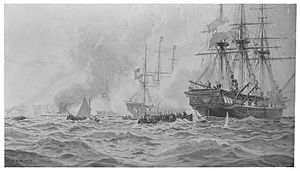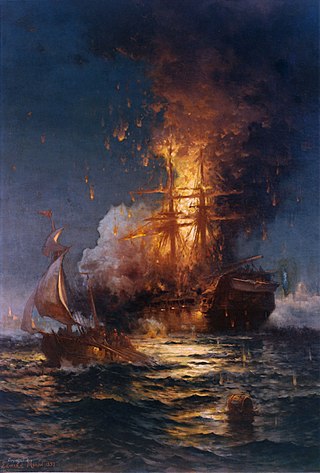
The Barbary Wars were a series of two wars fought by the United States, Sweden, and the Kingdom of Sicily against the Barbary states and Morocco of North Africa in the early 19th century. Sweden had been at war with the Tripolitans since 1800 and was joined by the newly independent US. The First Barbary War extended from 10 May 1801 to 10 June 1805, with the Second Barbary War lasting only three days, ending on 19 June 1815. The Barbary Wars were the first major American war fought entirely outside the New World, and in the Arab World.

The Second Barbary War, also known as the U.S.–Algerian War and the Algerine War, was a brief military conflict between the United States and the North African state of Algiers in 1815.
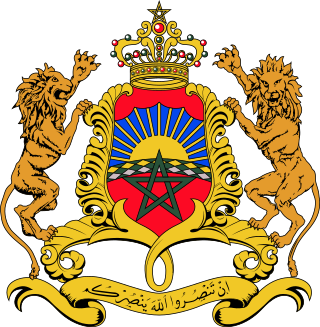
The 'Alawi dynasty – also rendered in English as Alaouite, 'Alawid, or Alawite – is the current Moroccan royal family and reigning dynasty. They are an Arab sharifian dynasty and claim descent from the Islamic prophet Muhammad through his grandson, Hasan ibn Ali. Their ancestors originally migrated to the Tafilalt region, in present-day Morocco, from Yanbu on the coast of the Hejaz in the 12th or 13th century.

The Barbary pirates, Barbary corsairs, or Ottoman corsairs were mainly Muslim pirates and privateers who operated from the Barbary states. This area was known in Europe as the Barbary Coast, in reference to the Berbers. Slaves in Barbary could be of many ethnicities, and of many different religions, such as Christian, Jewish, or Muslim. Their predation extended throughout the Mediterranean, south along West Africa's Atlantic seaboard and into the North Atlantic as far north as Iceland, but they primarily operated in the western Mediterranean. In addition to seizing merchant ships, they engaged in razzias, raids on European coastal towns and villages, mainly in Italy, France, Spain, and Portugal, but also in the British Isles, the Netherlands, and Iceland.

MoulayAbd al-Rahman bin Hisham, born on 19 February 1778 in Fes and died on 28 August 1859 in Meknes, was a sultan of Morocco from 30 November 1822 to 28 August 1859, as a ruler of the 'Alawi dynasty. He was a son of Moulay Hisham. He was proclaimed sultan in Fes after the death of Moulay Sulayman.

MawlaySulayman bin Mohammed, born on 28 June 1766 in Tafilalt and died on 28 November 1822 in Marrakesh, was a Sultan of Morocco from 1792 to 1822, as a ruler of the 'Alawi dynasty. He was proclaimed sultan after the death of his half-brother al-Yazid. Sulayman continued his father's centralization and expansion of the kingdom, and most notably ended the piracy that had long operated from Morocco's coast. As part of Morocco's long running conflict with Spain and Portugal, Sulayman halted all trade with Europe. However, he continued his father's policies of close relations with the United States. He was also a follower of Wahhabism.
Sidi Mohammed ben Abdallahal-Khatib, known as Mohammed III, born in 1710 in Fes and died on 9 April 1790 in Meknes, was the Sultan of Morocco from 1757 to 1790 as a member of the 'Alawi dynasty. He was the governor of Marrakesh around 1750. He was also briefly sultan in 1748. He rebuilt many cities after the earthquake of 1755, including Mogador, Casablanca, and Rabat, and Abdallah Laroui described him as "the architect of modern Morocco." He also defeated the French in the Larache expedition in 1765 and expelled the Portuguese from Mazagan (al-Jadīda) in 1769. He is notable for having been the leader of one of the first nations to recognize American independence in his alliance with Luis de Unzaga 'le Conciliateur' through correspondence and Unzaga's secret intelligence service and led by his brothers-in-law Antonio and Matías de Gálvez from the Canary Islands. He was the son of Mawlay Abdallah bin Ismail and his wife a lady of the Chéraga guich tribe.

The Regency of Algiers was a largely independent tributary state of the Ottoman Empire during the early modern period, located on the Barbary Coast of North Africa from 1516 to 1830. Founded by the corsair brothers Aruj and Hayreddin Barbarossa, the Regency was a formidable pirate base infamous for its corsairs. First ruled by Ottoman regents, it later became a sovereign military republic that plundered and waged maritime holy war against European Christian powers.

The Great Siege of Gibraltar was an unsuccessful attempt by Spain and France to capture Gibraltar from the British during the American Revolutionary War. It was the largest battle in the war by number of combatants.

Thomas Barclay was an American merchant, consul, and diplomat. He served as the United States' consul in France (1781–1787) and, during his time as a diplomat, negotiated the United States' first treaty, the Moroccan–American Treaty of Friendship, with the sultan of Morocco in 1786. He was the first American diplomat to die in a foreign country in the service of the United States.
Diplomacy was a central component of the American Revolutionary War and broader American Revolution. In the years leading up to the outbreak of military hostilities in 1775, the Thirteen Colonies and Great Britain had sought a peaceful diplomatic solution within the British political system. Once fighting began, diplomacy in the American Revolutionary War became critical to each faction for both strategic and ideological reasons. The American colonists sought forward aid and support to counter Great Britain's overwhelming strategic, military, and manpower advantages as well as to garner political legitimacy through international recognition; Great Britain sought to contain these diplomatic overtures while also leveraging its foreign relations with Native American tribes and German states. The American Declaration of Independence in July 1776 escalated these developments as the erstwhile sovereign United States evolved an independent foreign policy. Diplomacy would prove critical to shaping the trajectory and outcome of the war, as Americans relations with several foreign powers—particularly France and Spain—allowed access to decisive war material, funds, and troops while at the same time isolating Britain globally and spreading thin its military.
Lodewijk Count van Bylandt was a Dutch lieutenant-admiral. He gained a certain notoriety in the Affair of Fielding and Bylandt of 1779 and even more in consequence of the refusal of the Dutch navy to put out to sea to combine with the French fleet in Brest in 1783, during the Fourth Anglo-Dutch War, for which refusal many held him responsible. He was court-martialed and exonerated in the first case, and in the second case an inquiry into his conduct was long delayed and eventually quietly abandoned after stadtholder William V had prevailed against the Patriots in 1787. This made his promotion to lieutenant-admiral possible. He died in office as inspector-general and commander of the gunners corps of the navy of the Dutch Republic.
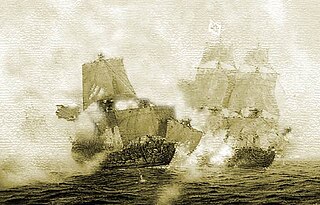
The action of 28 November 1751 was a naval engagement off Cape St. Vincent between a squadron of two Spanish ships of the line under captain Pedro Fitz-James Stuart and an Algerine squadron of two ships of the line under corsair Mohammed Chirif, which was fought from November 28 to December 2, 1751, and resulted in a victory for the Spanish fleet. The Algerine ships had come from the port of Algiers, and were acting as corsairs, conducting commerce raiding against Christian merchant ships and enslaving their crews. This was part of the Barbary slave trade, where the Barbary states, autonomous vassals of the Ottoman Empire, raided Christian settlements and merchant vessels for slaves to sell in their own cities. The corsairs targeted Spain, a Christian country, and the Spanish Navy was sent to track down the formidable Algerine force of two ships of the line, which posed a significant threat to any Christian vessels in the region. When the fleets sighted each other on November 28, 1751, they found that they were evenly matched with their opposition; both fielded two ships of the line.

The Expedition of Larache occurred in June 1765 when French Navy Marines attempted to invade the Moroccan city of Larache following a bombardment of Salé and Rabat. It is an example of the sporadic failure of Western arms against local forces in colonial campaigns.
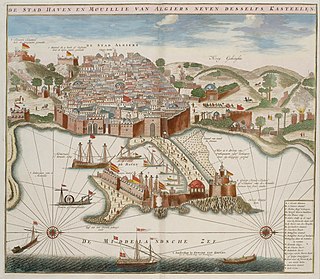
The 2nd Bombardment of Algiers took place between 12 and 21 July 1784. A joint Spanish-Neapolitan-Maltese-Portuguese fleet commanded by the Spanish Admiral Antonio Barceló bombarded the city, which was the main base of the Barbary corsairs, with the aim of forcing them to interrupt their activities. The second bombardment followed a similarly failed expedition the preceding year.
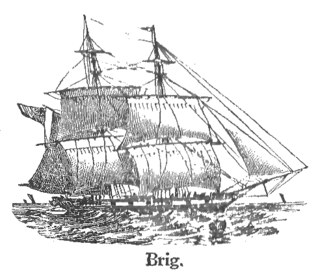
Insurgent privateers were private armed vessels recruited by the insurgent governments during the Spanish American wars of independence to destroy Spanish trade and capture Spanish merchant vessels.

The Anglo-French War, also known as the War of 1778 or the Bourbon War in Britain, was a military conflict fought between France and Great Britain, sometimes with their respective allies, between 1778 and 1783. As a consequence, Great Britain was forced to divert resources used to fight the American War of Independence to theatres in Europe, India and the West Indies, and to rely on what turned out to be the chimera of Loyalist support in its North American operations. From 1778 to 1783, with or without their allies, France and Britain fought over dominance in the English Channel, the Mediterranean, the Indian Ocean and the Caribbean.

Until 1815 the Beylik of Tunis maintained a corsair navy to attack European shipping, raid coastal towns on the northern shores of the Mediterranean and defend against incursions from Algiers or Tripoli. After 1815 Tunis tried, with limited success, to create a modern navy, which fought in the Greek War of Independence and the Crimean War.
The Capture of the Rif took place in 1792 and was orchestrated by the Bey of Oran, Mohammed el-Kebir, to capture the eastern Rif region in northern Morocco.

The Algerian–American War was a state of conflict which existed between the Regency of Algiers and the United States that lasted from 1785 to 1795. Occurring after the U.S. became independent from the British Empire as a result of the American Revolutionary War, Algiers declared war on the United States after realizing that American merchant shipping was no long under the protection of the Royal Navy.
